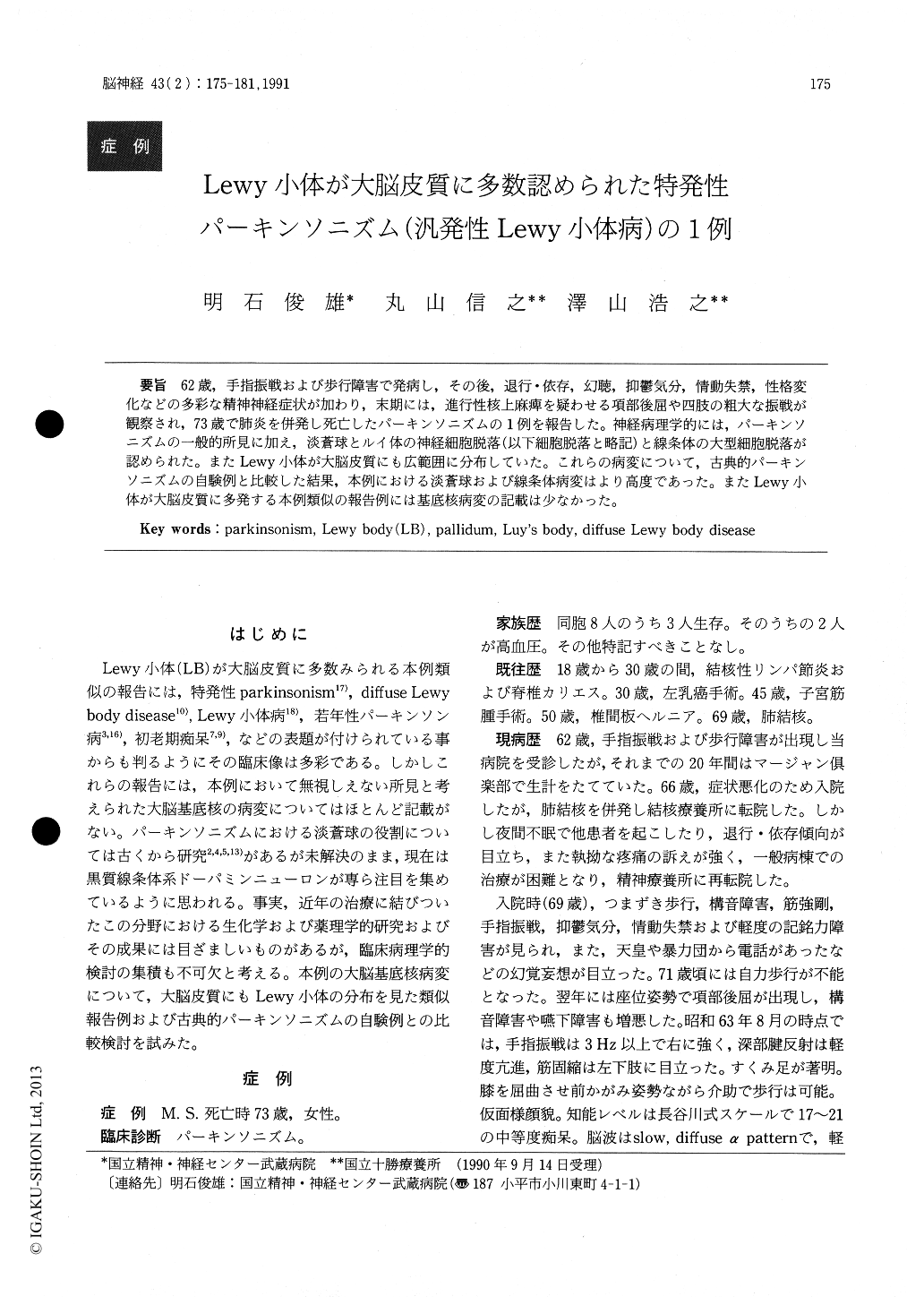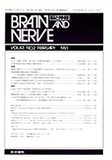Japanese
English
- 有料閲覧
- Abstract 文献概要
- 1ページ目 Look Inside
62歳,手指振戦および歩行障害で発病し,その後,退行・依存,幻聴,抑鬱気分,情動失禁,性格変化などの多彩な精神神経症状が加わり,末期には,進行性核上麻痺を疑わせる項部後屈や四肢の粗大な振戦が観察され,73歳で肺炎を併発し死亡したパーキンソニズムの1例を報告した。神経病理学的には,パーキンソニズムの一般的所見に加え,淡蒼球とルイ体の神経細胞脱落(以下細胞脱落と略記)と線条体の大型細胞脱落が認められた。またLewy小体が大脳皮質にも広範囲に分布していた。これらの病変について,古典的パーキンソニズムの自験例と比較した結果,本例における淡蒼球および線条体病変はより高度であった。またLewy小体が大脳皮質に多発する本例類似の報告例には基底核病変の記載は少なかった。
We report an autopsy case of a 73 year-old female with idiopathic parkinsonism, characterized path-ologically by the wide spread appearance of Lewy bodies (LBs) not only in the pigmented neurons in the midbrain and brainstem but also in the cerebral cortex. Initial symptoms at the age of 62 were finger tremor and gait disturbance, which were followed mainly by mental deterioration, such as regression, dependency, auditory hallucination, depression, emotional incontinence, and a personality change. In the terminal stage, nuchal stiffness in extension, one of the hallmarks of progressive supranuclear palsy, and slow and generalized tremor in all 4 extremities were noted. She died of aspiration pneu-monia.
The brain was somewhat small and weighed 1100 g after the fixation by formalin. Macroscopical findings included mild cerebral atrophy with mild pial thickening both in the frontal and temporal lobes and slight expansion of the ventricular system. Histopathologically, severe loss of neuronal cells in both the pallidum and Luy's body and moderate loss of large cells in the putamen were noted in addition to the typical findings of Parkinson's disease in the substantia nigra and locus caeruleus including neur-onal cell loss, depigmentation, and gliosis. These findings in the basal ganglia were more conspicuous than the two controls of classical Parkinson's disea-se. The distribution, stainability in the routine methods of staining, and shape of Lewy bodies in the cerebral cortex conformed to those of previous reports. The similar case reports in the literatures do not seem to have paid much attention to the findings of the basal ganglia observed in our case. With regard to the senile changes, neurofibrillary tangles in the cerebral cortex appeared only in the Ammon's horn and the parahippocampal gyrus, but senile plaques were not detected throughout the brain. These senile changes were thought to bewithin normal limits for the age of the patient.
Although there are not a few studies on the role of the globus pallidus in parkinsonism, the main target of interest in the fields of neuropathology, neuro-chemistry, and allied studies are focused, at present, on the nigro-striatal dopaminergic system. How-ever, for further understanding of parkinsonism inthe neuropathological studies, more precise investi-gations on the basal ganglia regions other than the commonly affected areas, i. e., substantia nigra and locus ceruleus, appear to be essential in parkin-sonism.

Copyright © 1991, Igaku-Shoin Ltd. All rights reserved.


